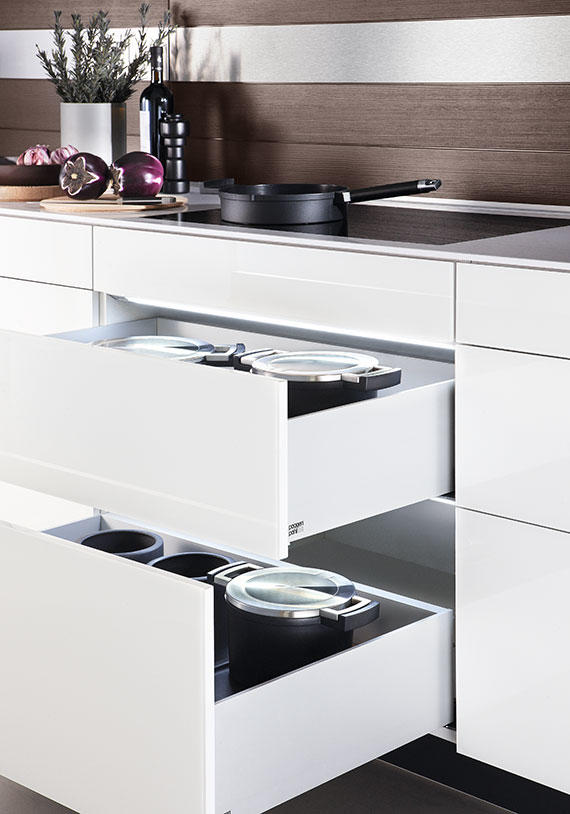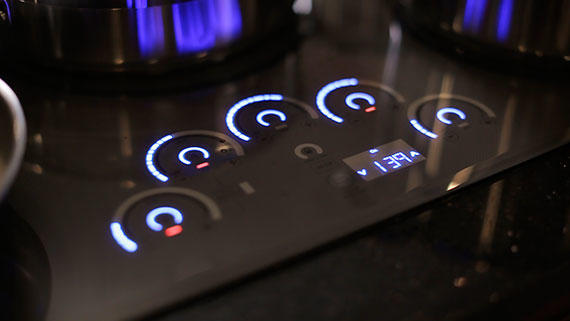Trending
Kitchen couture
Go seamless: Appliances and cabinets embrace technology and lose their handles

A quiet evolution is rippling through kitchen design today, smoothing surfaces and hiding the business parts.
Call it a kitchen make-under — the opposite of a makeover. That’s because many kitchens today are being designed with cabinets and large appliances that lack handles and appear to blend into the room, offering a seamless effect. But the goal is not a sterile space: Opulent or natural materials like semi-precious stones or wood are also being used to add detail and texture.
“People are seeking a combination of glam and streamlined,” said Marcia Butler, a Manhattan interior designer. “For example, a luxurious stone that shows every nook and cranny of Mother Earth, combined with cabinets where all you see are the doors.”
But one drawback to not having handles and knobs: Fingerprints can end up everywhere. It’s not for everyone, she cautions, but it’s a great look for those who can clean frequently.
Butler attributes a desire for clear surfaces as a “natural exposition of how we use our devices today.” In that sense, modern kitchens are like a smartphone or tablet, where apps stay hidden until needed. She recommends her clients stash their small appliances like coffee makers or grinders in deep drawers when not in use.
Read on for a look at some of the hottest trends in the city’s most upscale kitchens.
Technology opens doors
A gentle touch opens drawers designed by Poggenpohl, making the bulky handles unnecessary. “Just apply one pound of pressure and an electric back arm pushes the drawer forward,” said Roger Zierman, interior designer and showroom manager for Poggenpohl Park Avenue.
And to shed light on what’s hidden away in drawers: Some kitchen designers are installing LED lighting that turns on automatically as drawers slide open, illuminating storage.
The trend isn’t limited to cabinetry. Poggenpohl also created a grip-free system for use with refrigerators: Slide a hand into a hidden vertical channel on the edge of the door to gently release it.
Similarly, an oven from Gaggenau is handle-free. It features a touch display that, with a simple click of a button, automatically opens the door.
Just a touch
Consumers’ expectations have changed in the past few years,” said Elliott Koehler, lead industrial designer for cooktops at GE Appliances. “They are used to touchscreens and smartphones, and want that kind of technology on other products they interact with.”
New cooktops from GE feature all-new touch controls, including a timer that can be programmed for each burner separately. Simply glide a finger along a semi-circular
dial-like feature or touch anywhere along the dial to control the heat.

One of the latest Gaggenau’s refrigerator models features a mechanism that allows users to electronically adjust the height of the top shelf. “If you buy taller items at the grocery store, you don’t need to clear the shelf or wrestle to move it,” said Zierman. “Just hit a button and
the shelf moves up or down.”
Fresh material
The use of opulent and natural materials continues to add warmth to kitchen designs.
“We are seeing an uptake in using more luxurious materials in the kitchen,” said Karen Williams, designer and principal at St. Charles of New York, a Manhattan-based design firm specializing in high-end kitchens. Williams incorporates metals, such as brass and nickel, as well as semi-precious gemstones (like agate quartz, white onyx and champagne quartzite) in her designs; she praises the dramatic element they add to countertops and kitchen surfaces.
“This is what people are looking for: They want kitchens to be practical but also have to be beautiful,” Williams said.
Natural elements soften the appearance of man-made materials prevalent in the kitchen. “Untreated, brushed woods in very light tones contrast with modern materials, such as metal, glass, Corian and bronze,” said Simone Biscottin, a designer for GD Cucine, a high-end Italian kitchen design company with a flagship showroom in Chelsea.
According to interior designers, some of the natural elements in demand today are Calacatta marble with thick brown and gold veins, lava stones, untreated dark walnut and oak with a strong grain pattern.
Butler, the interior designer, is currently working on a kitchen on the Upper West Side. The centerpiece will be a Caesarstone counter in Wild Rice, which is a light brown shade mixed with taupe tones. “What’s interesting about this counter is that we are doubling the thickness,” she said. Typically Caesarstone countertops are 1.25 inches thick. “We’re doing 2.5 inches for a chunky look.”
Other features in this new kitchen: A natural cork floor, white oak quarter-sawn cabinets with a light-brown brushed glaze, a pendant school house light from O’Lampia Studio on the Bowery and a farmhouse sink. The overall look, Butler said, is “warm traditional.”




